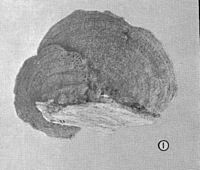|
 Phellinus senex Phellinus senex
SynonymsFomes senex var. bulbosetosus
Polyporus senex
Fomes zealandicus
BiostatusPresent in region - Indigenous. Non endemic
Images (click to enlarge)
Caption: Fig. 1. Fomes zelandicus, x 1/2. Showing zones on surface of pileus. |
Article: Gadgil, P.D. (in association with Dick, M.A.; Hood, I.A.; Pennycook, S.R.) (2005). Fungi on trees and shrubs in New Zealand. Fungi of New Zealand. Ngā Harore o Aotearoa 4: xi + 437 p. Hong Kong: Fungal Diversity Press.
Description: Type: Lignicolous Fungi; Description: Basidiomata perennial, solitary, firm and woody, attached by a broad lateral base. Pilei applanate or effused-reflexed, 30–250 mm wide, 40 mm thick. Pileus surface tomentose, becoming glabrous, concentrically sulcate and ridged, chestnut brown to cinnamon brown, darkening to deep brown when old, margin even, chestnut brown. Pore surface even, with a sterile border 1–3 mm wide, chestnut brown, darkening with age; pores stratose, small, 7–9 per mm. Context cinnamon brown, up to 5 mm thick. Hyphal system dimitic. Setae subulate, acuminate, 15–30 × 5–9 μm, chestnut brown. Basidiospores broadly ellipsoid, 4–6 × 3–4 μm, smooth, hyaline.
Distribution: Distribution: Northland, Auckland, Bay of Plenty, Wellington, Westland, Mid Canterbury, Stewart Island.; 1st Record: Cunningham (1927: as Fomes zelandicus — see Cunningham 1949).
Article: Dingley, J.M. (1969). Records of plant diseases in New Zealand. New Zealand Department of Scientific and Industrial Research, Bulletin 192: 298 p. Wellington:.
Notes: Cunningham (1948f) listed collections on Beilschmiedia, Carpodeotus and
Metrosideros as Fomes zealandicus Cke., but in 1965 separated F. senex from F.
zealandicus on morphology of the hymenial layer; he placed both species in the genus
Phellinus. Gilmour (1966a) listed it as causing a white pocket heart rot in these native
trees. It is of minor economic importance.
Article: Cunningham, G.H. (1948). New Zealand Polyporaceae. 8. The genus Fomes. New Zealand Department of Scientific and Industrial Research, Plant Diseases Division, Bulletin 79: 24 p.
Description: Hymenophore perennial, dimidiate, often imbricate, firm and woody. Pileus applanate,
effused-reflexed, sometimes resupinate, 3-25 cm. x 2-16 cm. x 0.5-4 cm.; surface bay-brown,
chestnut-brown, or umber towards the base, strongly concentrically sulcate and ridged, at first
tomentose, becoming glabrous, cuticle absent; margin bluntly rounded, fulvous or chestnut-brown, even; hymemal surface chestnut-brown, sometimes darker when old, even, slightly
glancing, sterile border 1-3 mm. wide, dissepiments not toothed. Context to 5 mm. thick,
chestnut-brown, of radiately arranged mainly parallel hyphae; skeletal hyphae to 4 µ thick,
wall 1 µ, yellow-brown or chestnut-brown, sparsely branched, pseudoseptate; generative
hyphae 3-3.5 µ thick, wall 0.5 µ, hyaline or tinted, branched, septate. Pores round, stratose, 2-4 mm. deep in each layer, ferruginous in section, 100-150 µ diameter, or 5-6 per mm.;
dissepiments 30-150 µ thick, equal, apex finely velutinate. Setae subulate, frequently dilated
at the base, apex acuminate, chestnut-brown, 24-32 x 6-8 µ. Basidia clavate, 8-12 x 4-5 µ.
Spores obovate, subglobose, or globose, 4.5-5.5 x 3-3.5 µ, smooth, hyaline, a few tinted
yellow.
Habitat: HABITAT: Growing solitary or imbricate upon bark or decorticated wood of dead standing
or fallen trunks associated with a white pocket-rot.
Distribution: DISTRIBUTION : New Zealand.
Notes: Characters of the species are the thin applanate pileus with strongly concentrically sulcate
surface, absence of a definite cuticle, chestnut-brown colour of context and hymenium, small
pores, subulate acuminate setae not exceeding 32 µ in length, and obovate small hyaline
spores. Collections forwarded to the late C.G.Lloyd and J.R.Weir were identified as Fomes
senex (Nees & Mont.) Cke. According to Lloyd (1915, p. 259) spores of the latter are deeply
coloured. Specimens so named (ex Mardai Road; Pahang; and Reservoir Jungle, Singapore),
forwarded by E.J.Corner, were found to possess hyaline spores of exactly the same size,
shape and colour as those of F. zelandicus. These and other similar features led Corner (1932,
p. 16) to suggest that both are co-specific. Singapore collections of F.senex differ, however;
for pores are 50-75 µ diameter, or 9-10 per mm., and dissepiments are 50-75 µ thick,
characters by which the species may be separated from ours.
|